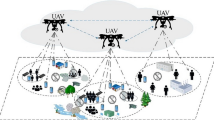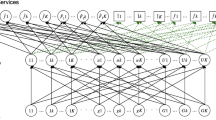Abstract
This article studies mobile edge computing technologies enabled by unmanned aerial vehicles (UAVs) in disasters. First, considering that the ground servers may be damaged in emergency scenarios, we proposed an air-ground cooperation architecture based on ad-hoc UAV networks. We defined the system cost as the weighted sum of task delay and energy consumption because of different delay sensitivity and energy sensitivity tasks in emergency communication networks. Then, we formulated the system cost-minimization problem of task scheduling and multi-UAV deployments. To solve the proposed mixed integer nonlinear programming problem, we decomposed it to two sub-problems that were solved by proposing a swap matching-based task scheduling sub-algorithm and a successive convex approximation-based multi-UAV deployment sub-algorithm. Accordingly, we propose a joint optimization algorithm by iterating the two sub-algorithms to obtain a low complexity sub-optimal solution. Finally, the simulation results show that (i) the proposed algorithm converges in several iterations, and (ii) compared with the benchmark algorithms, the proposed algorithm has better performance of reducing task delay and energy consumption and achieves a good trade-off between them for diverse tasks.
Similar content being viewed by others
References
Munich R. Natcatservice Loss Events Worldwide 1980–2014. Munich: Munich Reinsurance, 2015
Stanford D K. Unmanned aircraft systems. 2009. https://doi.org/10.1002/9780470664797.fmatter
Zeng Y, Zhang R, Lim T J. Wireless communications with unmanned aerial vehicles: opportunities and challenges. IEEE Commun Mag, 2016, 54: 36–42
Wang H, Wang J, Ding G, et al. Completion time minimization with path planning for fixed-wing UAV communications. IEEE Trans Wireless Commun, 2019, 18: 3485–3499
Xu Y, Zhang T, Liu Y, et al. UAV-assisted MEC networks with aerial and ground cooperation. IEEE Trans Wireless Commun, 2021, 20: 7712–7727
Zhao N, Lu W, Sheng M, et al. UAV-assisted emergency networks in disasters. IEEE Wireless Commun, 2019, 26: 45–51
Sun Y, Wang T, Wang S. Location optimization and user association for unmanned aerial vehicles assisted mobile networks. IEEE Trans Veh Technol, 2019, 68: 10056–10065
Ueyama J, Freitas H, Faical B S, et al. Exploiting the use of unmanned aerial vehicles to provide resilience in wireless sensor networks. IEEE Commun Mag, 2014, 52: 81–87
Sabella D, Vaillant A, Kuure P, et al. Mobile-edge computing architecture: the role of MEC in the Internet of Things. IEEE Consumer Electron Mag, 2016, 5: 84–91
Du J, Cheng W, Lu G, et al. Resource pricing and allocation in MEC enabled blockchain systems: an A3C deep reinforcement learning approach. IEEE Trans Netw Sci Eng, 2022, 9: 33–44
Messaoudi F, Ksentini A, Bertin P. On using edge computing for computation offloading in mobile network. In: Proceedings of IEEE Global Communications Conference (GLOBECOM), 2017
Du J, Yu F R, Lu G, et al. MEC-assisted immersive VR video streaming over terahertz wireless networks: a deep reinforcement learning approach. IEEE Int Things J, 2020, 7: 9517–9529
Liao Z, Peng J, Huang J, et al. Distributed probabilistic offloading in edge computing for 6G-enabled massive Internet of Things. IEEE Int Things J, 2021, 8: 5298–5308
Pham Q V, Ruby R, Fang F, et al. Aerial computing: a new computing paradigm, applications, and challenges. IEEE Int Things J, 2022, 9: 8339–8363
Zheng J, Anpalagan A, Guizani M, et al. Guest editorial: aerial computing: drones for multi-access edge computing. IEEE Wireless Commun, 2021, 28: 10–12
Cheng N, Xu W, Shi W, et al. Air-ground integrated mobile edge networks: architecture, challenges, and opportunities. IEEE Commun Mag, 2018, 56: 26–32
Liao Z, Ma Y, Huang J, et al. HOTSPOT: a UAV-assisted dynamic mobility-aware offloading for mobile-edge computing in 3-D space. IEEE Internet Things J, 2021, 8: 10940–10952
Erdelj M, Natalizio E, Chowdhury K R, et al. Help from the sky: leveraging UAVs for disaster management. IEEE Pervasive Comput, 2017, 16: 24–32
Zhang S, Cheng W. Statistical QoS provisioning for UAV-enabled emergency communication networks. In: Proceedings of IEEE Globecom Workshops (GC Wkshps), 2019. 1–6
Gu J, Su T, Wang Q, et al. Multiple moving targets surveillance based on a cooperative network for multi-UAV. IEEE Commun Mag, 2018, 56: 82–89
Budaev D, Amelin K, Voschuk G, et al. Real-time task scheduling for multi-agent control system of UAV’s group based on network-centric technology. In: Proceedings of International Conference on Control, Decision and Information Technologies (CoDIT), 2016. 378–381
Zhang L, Chakareski J. UAV-assisted edge computing and streaming for wireless virtual reality: analysis, algorithm design, and performance guarantees. IEEE Trans Veh Technol, 2022, 71: 3267–3275
Zhang T, Xu Y, Loo J, et al. Joint computation and communication design for UAV-assisted mobile edge computing in IoT. IEEE Trans Ind Inf, 2020, 16: 5505–5516
Zhang K, Gui X, Ren D, et al. Energy-latency tradeoff for computation offloading in UAV-assisted multiaccess edge computing system. IEEE Int Things J, 2021, 8: 6709–6719
Hu X, Wong K K, Yang K, et al. UAV-assisted relaying and edge computing: scheduling and trajectory optimization. IEEE Trans Wireless Commun, 2019, 18: 4738–4752
Wang L, Wang K, Pan C, et al. Deep reinforcement learning based dynamic trajectory control for UAV-assisted mobile edge computing. IEEE Trans Mobile Comput, 2022, 21: 3536–3550
Ning Z, Dong P, Wen M, et al. 5G-enabled UAV-to-community offloading: joint trajectory design and task scheduling. IEEE J Sel Areas Commun, 2021, 39: 3306–3320
Sun Y, Xu D, Ng D W K, et al. Optimal 3D-trajectory design and resource allocation for solar-powered UAV communication systems. IEEE Trans Commun, 2019, 67: 4281–4298
Cai Y, Wei Z, Li R, et al. Joint trajectory and resource allocation design for energy-efficient secure UAV communication systems. IEEE Trans Commun, 2020, 68: 4536–4553
Pang X, Zhao N, Tang J, et al. IRS-assisted secure UAV transmission via joint trajectory and beamforming design. IEEE Trans Commun, 2022, 70: 1140–1152
Tianze L, Muqing W, Min Z, et al. An overhead-optimizing task scheduling strategy for ad-hoc based mobile edge computing. IEEE Access, 2017, 5: 5609–5622
Haas Z J, Pearlman M R. The performance of query control schemes for the zone routing protocol. IEEE ACM Trans Netw, 2001, 9: 427–438
Yang Z, Pan C, Wang K, et al. Energy efficient resource allocation in UAV-enabled mobile edge computing networks. IEEE Trans Wireless Commun, 2019, 18: 4576–4589
Wang H, Wang J, Ding G, et al. Completion time minimization for turning angle-constrained UAV-to-UAV communications. IEEE Trans Veh Technol, 2020, 69: 4569–4574
Simon E P, Ros L, Hijazi H, et al. Joint carrier frequency offset and channel estimation for OFDM systems via the EM algorithm in the presence of very high mobility. IEEE Trans Signal Process, 2012, 60: 754–765
Zeng Y, Xu J, Zhang R. Energy minimization for wireless communication with rotary-wing UAV. IEEE Trans Wireless Commun, 2019, 18: 2329–2345
Bodine-Baron E, Lee C, Chong A, et al. Peer effects and stability in matching markets. In: Proceedings of the 4th International Conference on Algorithmic Game Theory, 2011
Scutari G, Facchinei F, Lampariello L. Parallel and distributed methods for constrained nonconvex optimization-part I: theory. IEEE Trans Signal Process, 2017, 65: 1929–1944
Scutari G, Facchinei F, Lampariello L, et al. Parallel and distributed methods for constrained nonconvex optimization-part II: applications in communications and machine learning. IEEE Trans Signal Process, 2017, 65: 1945–1960
Wang K Y, So A M C, Chang T H, et al. Outage constrained robust transmit optimization for multiuser MISO downlinks: tractable approximations by conic optimization. IEEE Trans Signal Process, 2014, 62: 5690–5705
Ongaro D, Ousterhout J. In search of an understandable consensus algorithm. In: Proceedings of USENIX Annual Technical Conference (USENIX ATC 14), 2014. 305–319
Zhou Y, Pan C, Yeoh P L, et al. Communication-and-computing latency minimization for UAV-enabled virtual reality delivery systems. IEEE Trans Commun, 2021, 69: 1723–1735
Zhang T, Wang Y, Liu Y, et al. Cache-enabling UAV communications: network deployment and resource allocation. IEEE Trans Wireless Commun, 2020, 19: 7470–7483
Acknowledgements
This work was supported in part by Beijing Natural Science Foundation (Grant No. 4222010), National Key Research and Development Program of China (Grant No. 2019YFC1511302), and Key Technology Research Project of Jiangxi Province (Grant No. 2013AAE01007).
Author information
Authors and Affiliations
Corresponding author
Rights and permissions
About this article
Cite this article
Zhang, T., Chen, C., Xu, Y. et al. Joint task scheduling and multi-UAV deployment for aerial computing in emergency communication networks. Sci. China Inf. Sci. 66, 192303 (2023). https://doi.org/10.1007/s11432-022-3667-3
Received:
Revised:
Accepted:
Published:
DOI: https://doi.org/10.1007/s11432-022-3667-3




